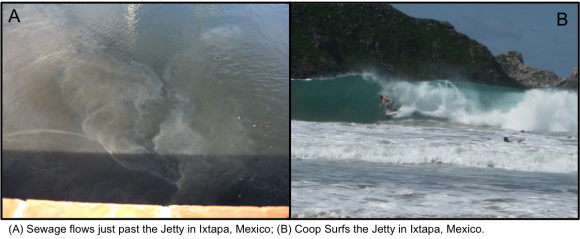Tuesday, July 16th, 2013...6:02 pm
Surfers V. Stormwater
My husband is an avid surfer- as are many of the friends I collected while living in Florida for 10 years. Yet somehow even living on a barrier island and working for a stormwater utility– I did not think much about the connections between stormwater and surfing. It was not until a trip to Mexico where I saw raw sewage draining into the water my [now] husband was surfing that I really thought about it- and of course, took pictures:
Cooper did not get sick or anything- but it turns out a lot of surfers do. According to a recent article in the New York Times, surfers in Los Angeles often complain of pink eye, fevers, and diarrhea when surfing after a rain storm. There is published research to back this up. A paper in Marine Pollution Bulletin found that due to high bacteria levels, the risk of gastro-intestinal illness to be elevated when surfing after a rain storm as compared to a non-rainy day. They also found that the risk of surfing was greater than the risk of swimming due to the higher likelihood of ingesting the polluted water. Another paper published in the Journal of Geophysical Research notes that the fecal bacteria released from storm outfalls tends to hug the shoreline and travel parallel to the shore for a long time before becoming “diluted” into the ocean (which, as we all know, is the solution to pollution).
Gross…what can we do about it?
Many coastal communities provide educational materials to their residents to inform them about the role they play in stormwater pollution (like this brochure from Honolulu, HI). Money collected from local stormwater utility fees can be used to install engineering controls that filter or hold the contaminated stormwater before it reaches the beaches (like these systems installed in Myrtle Beach, SC). A lot of effort is also put into making better warning signs (like these from New Hampshire) and keeping people from getting in the water in contaminated areas.
A study from the University of Southern California models a way to distribute beach amenities (parking, bathrooms, etc.) in a way to encourage beach goers to spend time at safer beaches, as opposed to those close to stormwater pipes. The article does not talk to much abut surfers specifically, which I find interesting- because, in my opinion, they are subset of beach goers who probably are not going to be detoured by a lack of any amenities- and might actually prefer it that way. Along these lines, the community at Surfers Point in Santa Barbara, California is participating in an “organized retreat” from the shoreline in order to combat stormwater pollution and erosion. This method combines conservation efforts with engineering controls such as permeable pavement and bioretention systems; it isn’t something that would work everywhere but it it one of the best approaches I’ve seen.
Do you surf even after it rains? Have you ever gotten sick? What are some of the special concerns of surfers vs. other beach goers that planners need to keep in mind?
And- while we’re at it, someone should start an American chapter of Surfers Against Sewage– an awesome UK-based organization- check out their short video at drift surfing, and a great paper co-written with Surfrider.









Leave a Reply